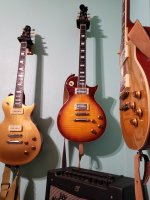“The country a guitar is made in does not matter much”: Paul Reed Smith thinks people should stop obsessing about guitars being made in America
“It’s always been about the skill level of the guitar makers.”
Paul Reed Smith – head honcho at PRS – has given fuel to the side of the debate that believes no, it doesn’t matter where a guitar is made.

guitar.com
I agree. My guitars are phenomenal. I didn't pay more than $300 for any of them. I guarantee if they were built to this level of quality in the US, they'd be $1200-$1500 easily. Probably even more than that. Every Indio guitar I've ever ordered from Monoprice came to me almost perfect out of the box. No exaggerating whatsoever.
While Firefly owners get guitars in this price range with multiple defects, mine had none pretty much.
No finish issues. No fitment issues. No binding issues. No paint issues. Bone nut had the slots cut to depth and not left high. Action set low. Relief always set at zero relief with no buzzing. Frets were finished amazingly well. All level. Fret ends rounded and polished. Zero sharp fret ends. And they all come with D'addario strings. The last one coming with coated D'addarios.
Even after getting the absolutely incredible 2023 Epiphone '1959 Les Paul Standard', I still say these guitars are a steal. They're easily built as well as the Epiphone. Most have thicker maple tops than the Epi, surprisingly. They're easily between 1/2" and 3/4" thick after contouring the top.
Absolutely terrific instruments. Especially for the $279 they cost. I was shocked by how great that first guitar was. So much that I bought 4 more guitars from them after the first one. With 2 of those being LP-style, called the '66 DLX Plus'. One T-style, called an 'Retro DLX Plus'. And one 335-style, called a Boardwalk. The "DLX Plus" is their top model. They also have a 66 Classic and a Retro Classic that come in around $129 instead of $249 or $279.
One thing I noticed is the goldtop with humbuckers has a different top carve than the others. I actually prefer it, tbh. It has contours and stuff. The other ones just seem generically round, without those contours.
They stopped selling that guitar in 2022 or 2023 and it's their best guitar. Even better than what they currently sell, IMHO.(They have a P90 Goldtop and the sunburst, both seen below, now.) So much that I've been considering picking up a used one in black. They were offered in gold or black only. I originally bought gold because of Duane Allman and his Goldtop.

Don't mind the Epiphone lol
















